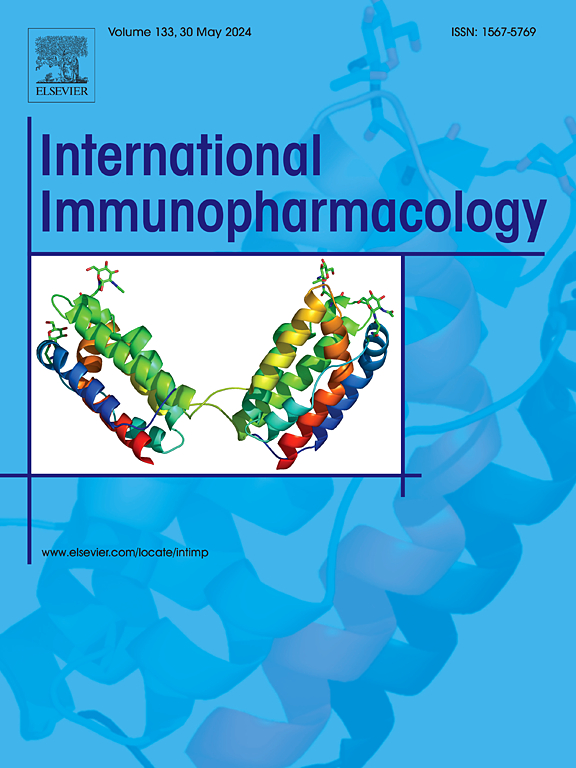用 mPLA 修饰的 VZV-gE 亚基疫苗可引起针对水痘-带状疱疹病毒的保护性细胞免疫反应。
IF 4.8
2区 医学
Q2 IMMUNOLOGY
引用次数: 0
摘要
带状疱疹是由潜伏的水痘-带状疱疹病毒再活化引起的一种急性传染性皮肤病,接种安全性较好的亚单位疫苗等可通过提高机体免疫力,有效预防带状疱疹。然而,蛋白质抗原容易降解和失活,这本身通常不足以诱导有效的免疫效果。为了提高带状疱疹病毒糖蛋白E (VZV-gE)的免疫原性,本研究建立了TLR4激动剂修饰的脂质体疫苗平台。采用薄膜分散和冷冻干燥的方法对VZV-gE进行包封,防止降解,提高脂质体的稳定性,并通过优化的冷冻保护剂获得更好的再溶效果。体外实验结果表明,mPLA能有效增强DC2.4对VZV-gE的吸收。体内免疫效果评价表明,制备的亚单位疫苗可诱导小鼠血清中IgG、IgG1和IgG2a抗体水平增强,提高体液免疫效果。脾细胞中Th1细胞因子(IFN-γ、IL-2)和Th2细胞因子(IL-4、IL-10)分泌水平显著升高,诱导保护性细胞免疫应答。总之,本研究表明,结合免疫调节佐剂修饰纳米载体开发亚单位疫苗平台是有效预防带状疱疹发生的一种有前景的策略。本文章由计算机程序翻译,如有差异,请以英文原文为准。

A VZV-gE subunit vaccine decorated with mPLA elicits protective cellular immmune responses against varicella-zoster virus
Herpes zoster is an acute infectious skin disease caused by the reactivation of latent varicella-zoster virus, vaccination, such as subunit vaccine with good safety, can effectively prevent shingles through increasing immunity of the body. However, protein antigens are prone to degradation and inactivation, which alone is generally not sufficient to induce potent immune effect. In this study, the liposomal vaccine platform modified with mPLA (TLR4 agonist) was developed to improve the immunogenicity of glycoprotein E (VZV-gE) derived from herpes zoster virus. The thin-film dispersion and freeze-drying methods were employed to encapsulate VZV-gE against degradation, enhance liposomal stability, and achieve better redissolution effects with an optimized cryoprotectant. The in vitro results presented that mPLA could effectively enhance the uptake of VZV-gE with DC2.4. In vivo immune effect evaluation showed that the prepared subunit vaccines could induce stronger IgG, IgG1, and IgG2a antibody levels in the mouse serum, improving humoral immune effects. And the secretion levels of Th1 cytokines (IFN-γ, IL-2) and Th2 cytokines (IL-4, IL-10) in the splenocytes were significantly increased, inducing protective cellular immune responses. Overall, this work presented that combining immunomodulatory adjuvants decorated nanocarriers to develop subunit vaccine platforms was a promising strategy to prevent the occurrence of herpes zoster effectively.
求助全文
通过发布文献求助,成功后即可免费获取论文全文。
去求助
来源期刊
CiteScore
8.40
自引率
3.60%
发文量
935
审稿时长
53 days
期刊介绍:
International Immunopharmacology is the primary vehicle for the publication of original research papers pertinent to the overlapping areas of immunology, pharmacology, cytokine biology, immunotherapy, immunopathology and immunotoxicology. Review articles that encompass these subjects are also welcome.
The subject material appropriate for submission includes:
• Clinical studies employing immunotherapy of any type including the use of: bacterial and chemical agents; thymic hormones, interferon, lymphokines, etc., in transplantation and diseases such as cancer, immunodeficiency, chronic infection and allergic, inflammatory or autoimmune disorders.
• Studies on the mechanisms of action of these agents for specific parameters of immune competence as well as the overall clinical state.
• Pre-clinical animal studies and in vitro studies on mechanisms of action with immunopotentiators, immunomodulators, immunoadjuvants and other pharmacological agents active on cells participating in immune or allergic responses.
• Pharmacological compounds, microbial products and toxicological agents that affect the lymphoid system, and their mechanisms of action.
• Agents that activate genes or modify transcription and translation within the immune response.
• Substances activated, generated, or released through immunologic or related pathways that are pharmacologically active.
• Production, function and regulation of cytokines and their receptors.
• Classical pharmacological studies on the effects of chemokines and bioactive factors released during immunological reactions.

 求助内容:
求助内容: 应助结果提醒方式:
应助结果提醒方式:


